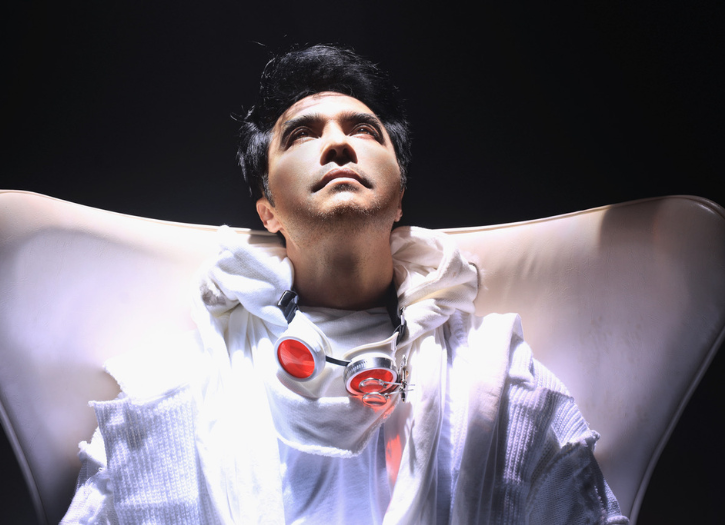Sir Daniel Winn is a man of many talents, most notably known for his fine art and opening his own Winn Slavin Fine Art gallery currently located on Rodeo Drive in Beverly Hills. Known internationally, the blue-chip artist is now excited to be making his cinematic art debut on the experimental short film entitled Creation.
Running 18 minutes in length, Creation is a Kubrick-style short that showcases Sir Daniel Winn’s artistic philosophy of Existential Surrealism through a mixture of visuals, music, art and dance. The tagline? “Creation begins where destruction ends.”
The film follows an artist who comes from another realm as he enters earth through a mysterious portal. The artist then begins by meditating, as visions of inspiration come seeping through. As a result, he begins his “Creation.” It starts with earthly elements such as dirt and clay, before transforming into two breathtaking sculptures: one male and one female.
Sir Daniel is the star of the film, which is produced by Emmy-winning producer Georges N. Chamchoum. Creation first debuted at the Asian World Film Festival in Los Angeles in 2022, and was recently accepted into the Experimental Dance & Music Film Festival, winning Best Long Format Short Film, and the Venice Shorts Film Festival, where it won Best Cinematography. In fact, it did so well that Daniel is submitting the film for Cannes Film Festival 2023 and planning the pre-production for the film’s feature-length version.
Sheen spoke with Sir Daniel Winn, who had just spent the prior evening at Elton John’s Oscar viewing party. Read below as we discuss his new film, why he chose to tell the story without any dialogue, and his philosophy of Existential Surrealism.

This is your film debut. What inspired you to expand into the medium of film?
I’ve always believed that art is an expression of visual language. My way of communicating my philosophy and my ideas, and the understanding of universal truth, is through my art. Rather than writing about the artwork or trying to explain it verbally, I want to have it visually communicated through a medium, whether it’s two-dimensional paintings or three-dimensional art.
Now, the next step is trying to create something in the realm of performance art, which is expanding into film. People say a picture’s worth a thousand words. With film, I’m hoping that every frame will have its own story. The visual language of universal truth communicated through film is so much more impactful than expressing it through a synopsis.
The interesting part about this short film is that there is no dialogue in its 18 minutes. Eventually we’re going to be doing the feature film, which will be approximately 90 minutes. It will also have no dialogue. I feel that the no-dialogue route is a way to transcend all languages. There are so many languages currently used and I don’t feel any one particular language is going to be sufficient to explain universal truth. So instead of trying to read or listen about my philosophy, people can watch the film and understand in their own way how it relates to their life experience, allowing them to connect with their personal experience and existence.
How is creating a film similar or different to sculpting or painting a work of three-dimensional art?
This is my first experience in the film world, which is also a form of art. It’s performance art rather than a visual art like a painting or sculpture. Nevertheless, it is an expression intended to have the viewer understand your emotion, your philosophy, your thoughts and ideas, and your innermost visions. But instead of seeing it through a painting or sculpture, you’re seeing through filming with many moving frames. The similarities are that they’re both forms of visual art.
As an artist, I create my art in my personal studio space. I control my composition, style, time and what I want to communicate. In painting and sculptures, you’re in a very private environment and you have privacy and solitude when creating. But in film, you have dozens of people all around all the time checking on makeup, props, the movement, the angles, and details that the film director requires. That’s the biggest difference. You have a cameraman, the lighting person, the director, the crew, the staff, the music, the score, and the cinematography. There are many other players and artisans. And you need everybody there to ensure that the visual language or communication is being expressed in the film. Everyone has to be in sync to make it a beautiful, spectacular film. Based on my first experience in film, I feel it is a much more complex way to communicate; however, the end result communicates so much more profoundly.
Can you explain why you decided to tell a story without dialogue?
Telling a story without a dialogue requires a lot of emotion that can be evoked through sound, music, and also the expression of the character. The protagonist in the film is the artist. You have to watch his facial expression, his movement, his eyes, and his demeanor. You have to watch the body language, the muscle tone, the way the character moves his fingers and arms, how he touches the elements and ultimately the sculptures he creates.
Because there’s no dialogue, you have to tell the story through body language, through music, and even how the character touches the clay. The film has to evoke all the senses of the viewers to capture their attention and have them understand what is being communicated. When you’re trying to communicate to a viewer verbally, you can tell a story and they listen. But in film, you’re not just verbally telling a story; you somehow have to communicate in ways they can emotionally connect with the message.
Imagine a person that communicates through sign language when they have no auditory abilities. The way they listen when they have no sound is through vibrations. The same applies with film: the way we communicate to the audience is through the vibration of the sound of the movie, in addition to watching the body language, the eye movements, and all the expressions the character exudes.
What inspired the idea behind the film?
Everybody always asks me about my paintings and sculptures and how I create them. So, I wanted to create a video to show the viewers how the process of my paintings and sculptures are done. But as I began the process of creating the video of an artist sculpting a masterpiece sculpture, I realized that film would be a great visual expression to share with the audience my process and also my artistic philosophy.
Instead of just trying to communicate with the viewer through video, I want to communicate with them on a much deeper level than just learning the process. I felt this could be an opportunity for the viewers to see my profound philosophy in addition to seeing how my artworks are produced. I contacted a great writer, award-winning director and producer, a sound composer, and began the process. I wasn’t sure how it’s going to turn out, but I felt it was a great way to convey my message of universal truth. And to my surprise, it worked. But it took time and painstaking dedication to make this short film the way I had envisioned.
I now understand and can appreciate the movie industry and what it takes to create a two-hour movie. I never understood why it’d take so long. But now, having gone through the process, I completely get it. It took us almost four months to create an 18-minute film. We spent hundreds of hours going over every single second of the film to make sure every frame captured exactly what we wanted to communicate.
Talk about the filmmaking process. What were the biggest challenges?
There were many challenges, but the biggest one was something we cannot control, like nature. For example, we needed rain in the desert. We had to wait and see what the weatherman said. It would be a gamble. If it rains, it’s perfect. If it doesn’t rain, we had to go with plan B utilizing equipment to make rain. This epic short film needed certain natural environments that cannot be replicated organically. The cinematography director had to select the film location and timing of the weather in order to capture the perfect visual effects for the film.
Somehow when we went to the desert, the rain happened exactly when we wanted it. When we went to Big Sur by the ocean, the light going through the clouds giving the perfect ray of light was serendipitous. Almost like somebody was watching over us and knew exactly what we needed. Mother nature gave us exactly what was necessary for the film. I’m astounded at how filmmakers can create something and wait for something uncontrollable like nature to work with you organically.
As for the process of filmmaking, it was arduous. In sculpture, sometimes it takes me months to create a sculpture in clay. It’d take me another year to create the finished clay in the bronze via the Lost Wax Process. During filming, we only had a specified number of days to shoot the entire process from clay to bronze. This film could not extend a year for the sculpture scene to be complete. Hence, there was so much work I had to do in advance to prep for the film crew to shoot it in just a few days to give a “fast-pace” process.
With the magic of cameras, they filmed and edited the Lost Wax Process so it looked like a year’s work was done in five minutes. I had to do everything in advance and duplicate it. When the director says “cut”, I’d have to bring in the next stage process of my sculpture creation. The next step would’ve taken me months to complete; so, I did it in advance for the film. When they’d shoot that scene, I’d bring in another partially completed sculpture that I’d completed months before. They kept doing takes over and over again with different stages of my artwork, so the progression looks much faster than years [laughs]. That part of the film was really arduous.
How does the film communicate your artist philosophy of Existential Surrealism?
Existential Surrealism is the understanding of universal truth: how we’re created, the meaning of life, and why we are here. This storyline has always been my concept. As mentioned previously, initially we were only going to make a video of the process of creating a sculpture. Ultimately, we made a short film instead about the process of creating sculptures and about my philosophy of Existential Surrealism. And poetically, we called the short film “Creation.”
The basic story is about an artist from another realm coming into a barren world creating two sculptures. In this journey of creation, the protagonist had to destroy in order to create. It’s a very complex artistic film that you have to see several times to grasp the small nuances and symbolisms. It’s tough to explain. This short film would take me hours to explain. Even then, it wouldn’t give you the satisfaction of understanding what universal truth is unless you see the film. When you watch for 18-minutes you grasp so much and you have a deeper appreciation of art. I’m excited to use film to enhance the understanding of my philosophical concept of universal truth.
What are your plans for the feature length version? How will you expand on the story?
The feature length version of the movie is going to be much more in depth and more epic. The short film was more of a trailer. It’s like a preface of a book, a treatment; and the main film will be the core of the story. We’re going to shoot it on four different continents. Iceland in Europe, Thailand in Asia, Costa Rica in South America, and Los Angeles, Arizona, and Utah in the US. The four continents will capture all the elements of the world, so it’ll give much more depth, grandeur, and an epic story to the film. As for the short film, we’re very proud of what was done. It was officially selected to the Experimental Film Festival, it was nominated. We just found out last week that it won Best Short Film at the Experimental Film Festival. And we also just won Best Cinematography at the Venice Shorts Film Festival.
How does that feel?
It was a surprise to me. But I believe because the short film was so unique and so different, somehow the audience, the judges, and the critics found it intriguing. They sent us information that it won Best Picture. It’s going to be featured in the festival circuit in May in New York and LA. We submitted to other festivals as well and are awaiting their response. If everything goes well, I’m hoping it will win more accolades. Thus far, to be officially selected and nominated for a couple of prestigious film festivals was already an honor, let alone winning. We are extremely honored.

What do you hope viewers take away from watching Creation?
The film festival sent us the audience’s reviews. We hadn’t heard reviews from the audiences up to that point; only from film critics. The director, DP, producer, and all of us were excited to hear the reviews. Interestingly, some viewers saw the film as very spiritual and referred to the film as a spiritual awakening. Some perceive the story as an artistically creative film and viewed it as a powerful love letter to art and how art comes to life. And some audiences saw it as being very religious in nature and even compared it to a sci-fi that had an Old-Testament feel. The interpretations varied from one extreme to the other, which is exactly what we wanted to communicate. I feel we truly accomplished giving the audience many very different aspects of what the meaning of life is and what they think universal truth is.
Anything else you want to let the people know?
I hope everyone eventually will see this film because I believe it will change their views on what creation represents. It’s a unique, artistic, and avant-garde way of trying to explain universal truth. I want people to have an opportunity to go see this film and interpret their own personal meaning. It’s 18 minutes that could make an impact on one’s current existence and possibly give an opportunity to view one’s life and their place in the universe.
Photos Credits: Courtesy of Sir Daniel Winn







Sir Daniel Winn | CREATION | Award Winner | VENICE SHORTS FILM AWARD
https://www.instagram.com/reel/CrhOqwnNCGm/?utm_source=ig_web_copy_link